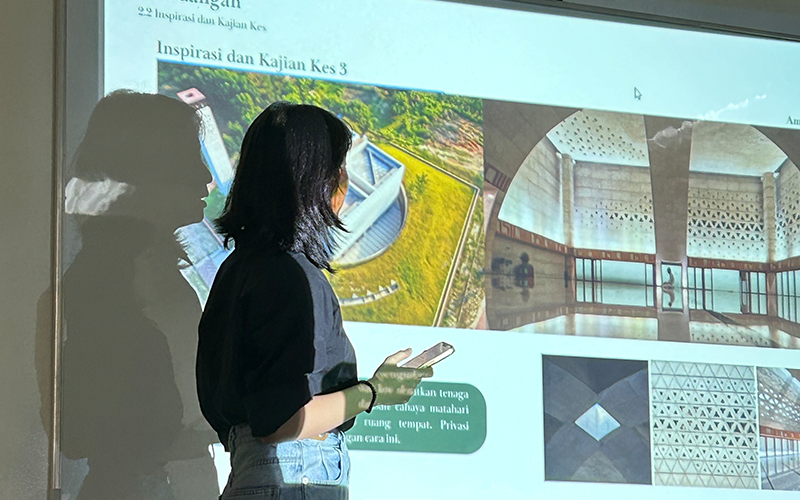{{ vm.tagsGroup }}
03 Aug 2024
5 Min Read
Taylor's Impact Lab (Liveable Urban Communities)
Redesigning PPR Seri Cempaka’s 'Surau & Community Hall' is a project by Taylor’s University as a contribution towards achieving SDG 11. As part of Taylor's Liveable Urban Communities Impact Lab programme, the project involved six groups of third-year students from the School of Architecture, Building, and Design.
It began with a call for design proposals from the architecture students, challenging them to redesign the existing surau and community hall structure into spaces that are not only practical and sustainable but also reflect the cultural and social fabric of the community. The designs needed to address the limited space available while providing a welcoming environment for worship, gatherings, and community activities.
These groups of students, along with the support of their lecturers, Dr Soon Lam Tatt, Mr Ahmad Fahmi Zainazlan, Mr Khairool Aizat Bin Ahmad Jamal and Ms Shirley Chin Ai Ling, came up with new designs and proposed renovation costs for the prayer hall and community hall spaces at PPR Seri Cempaka, with the aim of presenting them to the residents to then vote for their favourite design to be implemented and built. In collaboration with the Liveable Urban Communities Impact Lab, Taylor’s Community supported this project through its Corporate Social Responsibility (CSR) arm.
Design Presentation by Students
Ms Zuraimah, a committee member of the Surau, had expressed concerns about the current state of the surau which included leaking pipes in the ceiling that caused water to drip down, as well as the impractical layout of the toilet and ablution area where only one such dedicated area was available – thus reducing privacy for women who wished to have a separate space. Hopes of such issues being solved were among the reasons why many residents like Ms Zuraimah looked forward to this project taking place.
A unique aspect of this initiative was the active involvement of the residents. They were given the opportunity to vote for the design they felt best met their needs and aspirations. This participatory approach ensured that the final design would be truly reflective of the community's desires and practical requirements.
Residents of PPR Seri Cempaka visiting the Students’ Design Exhibition
Amidst the excitement surrounding the innovative designs for the surau and community hall at PPR Seri Cempaka, some residents expressed important concerns about safety. Mr Rizal, a resident and member of the Search and Rescue Training Team at Universiti Malaya, highlighted that some designs seemed to prioritise aesthetics and cost, without sufficient attention to fire safety regulations.
He pointed out potential issues, such as unspecified ceiling changes that would affect fire safety, the inclusion of sliding doors which might pose a hazard to children, and the lack of details about fire extinguishers. On behalf of the students, Taylor’s University lecturer Mr Khairool acknowledged that the initial focus was indeed on design and costing as per their syllabus requirements. However, he assured that comprehensive follow-up assessments regarding fire safety would be conducted before the construction phase, ensuring that all necessary safety measures would be in place.
Director of Liveable Urban Communities Impact Lab, Associate Professor Dr Camelia May Li Kusumo said, “This was a good exposure for our third-year Architecture students considering that they got to present to real-life clients, providing them with direct engagement before going into real-life work.
During the engagement session, they were able to get practical feedback especially on technical issues that they might not have been exposed to before. They also had the chance to do such presentations while speaking Bahasa Malaysia, which was a different experience for them compared to primarily using English in university. Residents also couldn’t imagine what their future space could look like, but the presentations helped to give them a visualisation of the new enhanced space that made them feel quite satisfied.”
Group of Students with their Top-Scoring Design
The top-scoring, chosen design will be brought to life – serving as a model for future projects and demonstrating the power of student creativity and community collaboration in addressing real-world challenges. It is an example of student design projects going beyond mere competition, to provide a hands-on educational experience for students and a transformative initiative for the residents of PPR Seri Cempaka.
By bridging the gap between academic learning and practical application, as well as aligning with the United Nations' Sustainable Development Goal 11, the Liveable Urban Communities Impact Lab helps to fosters a new generation of socially conscious and skilled professionals, on top of successfully demonstrating how innovative design and active community involvement can create inclusive, safe, and sustainable urban spaces.


